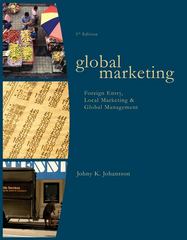Question
I need this to be less AI generated after finding sources on the web. Please edit this with normal vocabulary International trade allows countries to
I need this to be less AI generated after finding sources on the web. Please edit this with normal vocabulary
International trade allows countries to specialize and exchange goods and services, providing mutual benefits. Two key concepts help explain this phenomenon: absolute advantage and comparative advantage.
Absolute Advantage:Imagine a scenario where Country A can produce both wheat and cars more efficiently than Country B. This is an absolute advantage. Country A needs fewer resources to produce the same amount of output. While intuitive, absolute advantage doesn't guarantee trade.
Comparative Advantage:This theory, introduced by David Ricardo, focuses onopportunity cost. Even if Country B is less efficient in everything, it might still trade. The key is to identify which good has alower opportunity costfor each country. For example, maybe Country B is much less efficient in wheat production but only slightly worse in car production compared to Country A. In this case, Country B might specialize in cars and trade with Country A for wheat. Both countries benefit by focusing on what they're relatively better at.
Heckscher-Ohlin Theory (H-O Theory):This theory delves deeper, suggesting trade patterns are influenced by a country'sfactor endowments. Countries rich in labor like Bangladesh will export labor-intensive goods like clothing, while capital-abundant nations like Japan will export capital-intensive goods like electronics. This theory explains why developing countries often specialize in textiles or agriculture.
New Trade Theory:This theory acknowledges the limitations of the previous models. It highlights the role ofeconomies of scaleandincreasing returns. If producing a good becomes cheaper as you produce more due to specialization and learning, countries can gain an advantage even without inherent resource differences. This explains why some countries dominate specific industries like aircraft manufacturing.
Empirical Examples:
- China and the US:China, with its large labor force, has a comparative advantage in labor-intensive goods like toys. The US, with its technological prowess, has a comparative advantage in high-tech products. Both benefit from trade.
- Bangladesh and Apparel:Bangladesh, with its abundant labor, has become a major garment exporter, reflecting the H-O Theory.
- South Korea and Semiconductors:South Korea's heavy investment in R&D and infrastructure has given them a comparative advantage in semiconductors, showcasing the impact of economies of scale (New Trade Theory).
In conclusion,absolute advantage is a good starting point, but comparative advantage, with its focus on opportunity cost, provides a more nuanced view. H-O Theory explains trade based on resource endowments, while New Trade Theory highlights the role of economies of scale and technological advancements. All these theories contribute to our understanding of why countries trade and how resources are allocated globally.
Step by Step Solution
There are 3 Steps involved in it
Step: 1

Get Instant Access to Expert-Tailored Solutions
See step-by-step solutions with expert insights and AI powered tools for academic success
Step: 2

Step: 3

Ace Your Homework with AI
Get the answers you need in no time with our AI-driven, step-by-step assistance
Get Started


